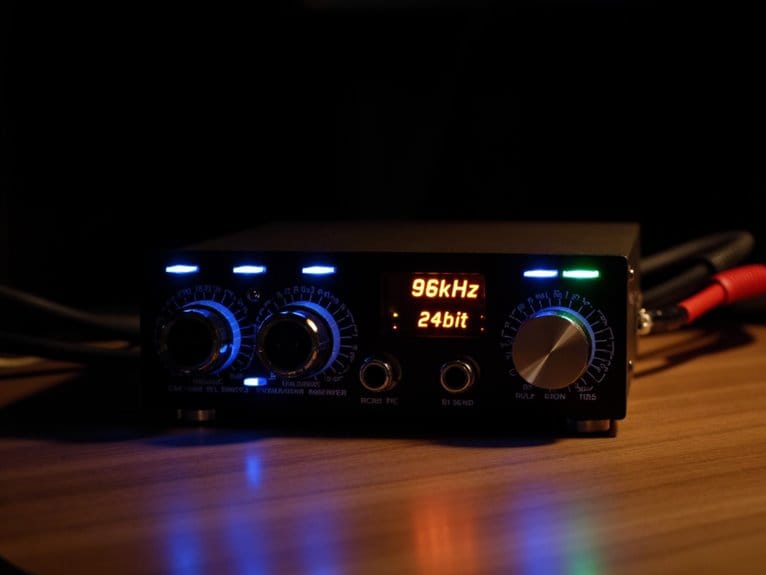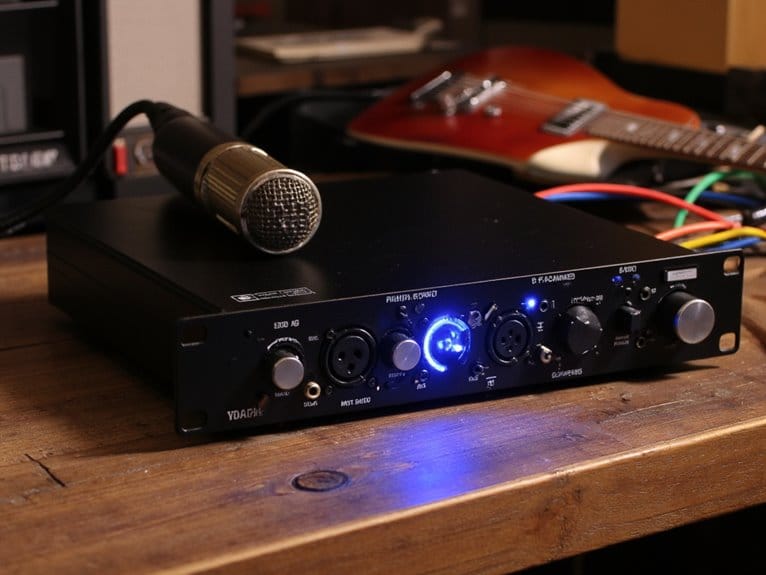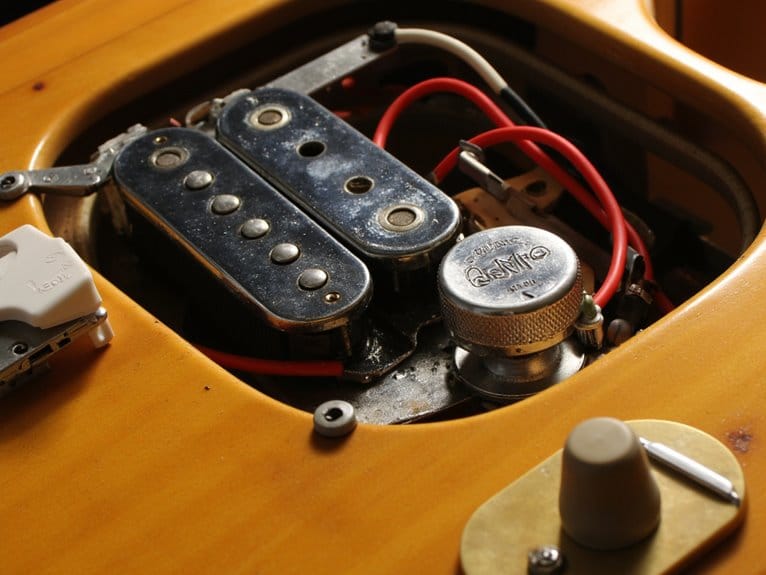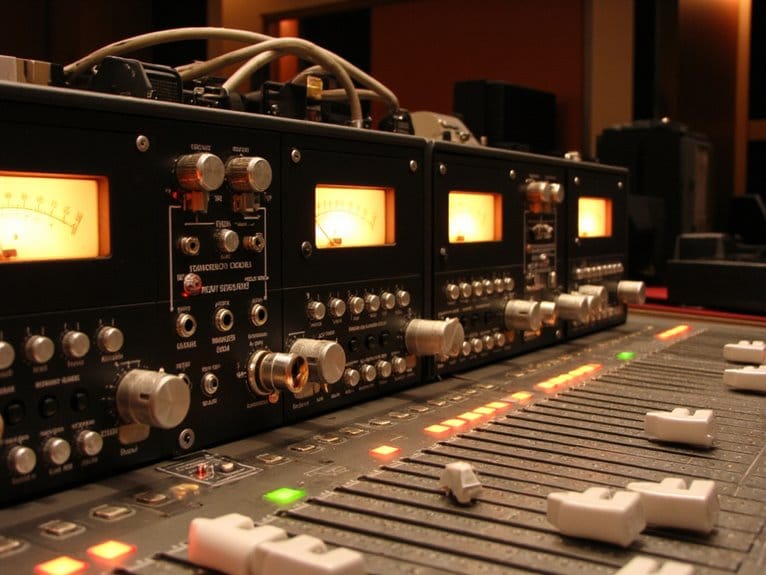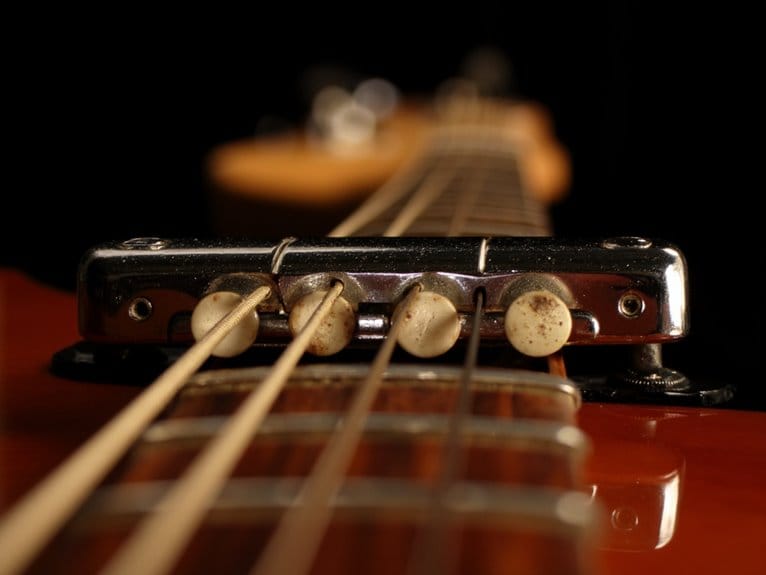Audio Interface Sample Rates and Bit Depth Explained
Sample rate determines how many times per second your audio interface captures sound, with 44.1 kHz being CD quality and 96-192 kHz offering professional detail, while bit depth controls amplitude resolution—16-bit provides 96 dB dynamic range versus 24-bit’s expansive 144 dB range. You’ll want 24-bit/48 kHz for broadcast work, 24-bit/96 kHz for high-fidelity music production, though higher settings demand considerably more storage space. Understanding these specifications helps you optimize recording quality while managing workflow efficiency and file sizes throughout your production process.
We are supported by our audience. When you purchase through links on our site, we may earn an affiliate commission, at no extra cost for you. Learn more.
Notable Insights
- Sample rate measures how often an analog signal is captured per second, with 44.1 kHz being CD quality standard.
- Bit depth determines amplitude levels per sample, with 24-bit providing superior dynamic range over 16-bit recordings.
- Higher sample rates and bit depths capture more detail but require significantly more storage space and processing power.
- Professional recording typically uses 24-bit/48 kHz or higher, while consumer audio often uses 16-bit/44.1 kHz standards.
- Audio interface connectivity and preamp quality directly impact recording latency, noise levels, and overall audio clarity.
Understanding Sample Rate Fundamentals
When I’m working with audio gear, I’ve learned that sample rate represents the fundamental building block of digital audio conversion, measuring how many times per second an analog signal gets captured and transformed into digital data points.
You’ll find that sample rate variations directly impact your recording quality, with measurements expressed in Hertz like 44.1 kHz or 96 kHz. Higher rates capture more detail but demand greater storage space and processing power, creating a constant balance between quality and practicality.
Since human hearing typically ranges from 20 Hz to 20,000 Hz, the Nyquist theorem requires at least 40 kHz sampling to accurately reproduce these frequencies, which explains why 44.1 kHz became the standard for CD-quality audio reproduction. Professional audio production environments often utilize higher sample rates like 96 kHz or 192 kHz to achieve enhanced accuracy during recording and mixing processes. Lower sample rates can create aliasing distortion, introducing unwanted noise artifacts that compromise your final recording quality.
Exploring Bit Depth Basics
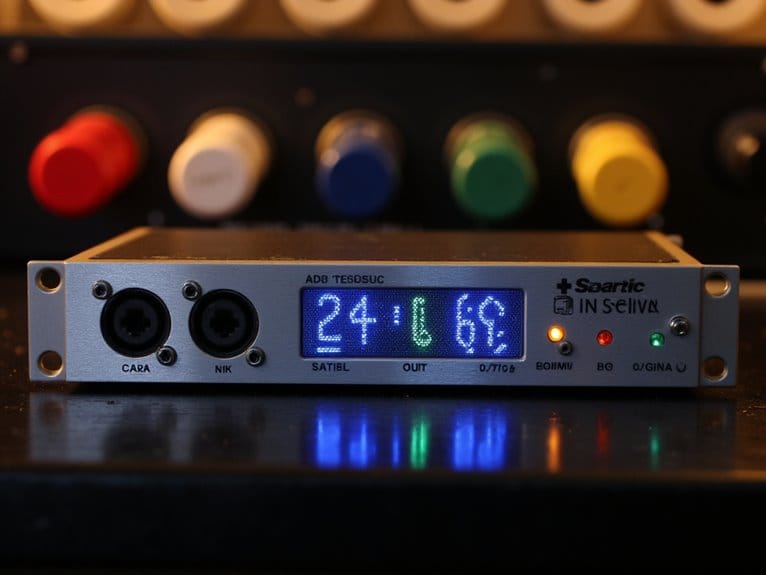
Now that you understand sample rates, let’s examine bit depth, which determines how many discrete amplitude levels your audio interface can capture for each individual sample.
You’ll typically encounter three main options: 16-bit for basic consumer audio, 24-bit for professional recording that offers considerably lower noise floors, and 32-bit floating point for mixing applications where you need maximum headroom.
The higher bit depths provide dramatically expanded dynamic range, allowing you to capture both whisper-quiet details and thunderous peaks without sacrificing audio quality or introducing unwanted quantization noise. A 24-bit recording has significantly more amplitude value possibilities than a 16-bit recording, providing greater detail in captured audio similar to how megapixels work in photography. Adding low-level noise through dither can actually correct quantization distortion that occurs during the analog-to-digital conversion process.
What Is Bit Depth
The foundation of digital audio recording rests on an essential concept that determines how precisely your audio interface captures the amplitude of each sound wave sample—bit depth.
Think of it as the resolution of your digital camera, but for sound amplitude measurements instead of visual pixels.
When your interface converts analog signals to digital, it measures each sample’s amplitude and assigns it to the nearest available level determined by bit depth.
Here’s what this means for your recordings:
- Each additional bit doubles the available amplitude levels
- 16-bit provides 65,536 discrete amplitude steps
- 24-bit offers over 16 million possible levels
- Higher depths reduce quantization error considerably
Understanding bit depth effects helps you capture quieter details with greater precision, minimizing the rounding errors that create unwanted noise in your final recordings. The noise floor becomes significantly quieter as bit depth increases, with 16-bit audio typically reaching around -96 dBFS while 24-bit audio extends to approximately -144 dBFS. This expanded dynamic range of 6 dB per additional bit provides professional recordings with superior clarity and headroom for mixing and mastering processes.
Common Bit Depth Options
Audio interfaces today offer three primary bit depth options, and I’ll walk you through what each one brings to your recording setup. When making bit depth comparisons, you’ll find that 16-bit provides 96 dB of dynamic range with 65,536 amplitude values per sample, making it perfect for final distribution formats like CDs. Moving to 24-bit dramatically expands your dynamic range to 144 dB with over 16 million amplitude values, which I recommend for professional recording and production work.
| Bit Depth | Dynamic Range | Best Use Case |
|---|---|---|
| 16-bit | 96 dB | Final distribution, streaming |
| 24-bit | 144 dB | Recording, mixing, production |
| 32-bit float | Theoretical maximum | DAW internal processing |
Don’t fall for common audio quality myths—higher bit depths won’t make your recordings sound “clearer,” but they’ll give you essential headroom during production. Recording at 24-bit eliminates concerns about signal levels and clipping compared to 16-bit systems. The increased dynamic range also results in a lower noise floor, reducing the amount of quantization noise that appears as low-level white noise in your recordings.
Dynamic Range Benefits
Understanding dynamic range transforms how you’ll approach recording decisions, and I’ve seen countless producers underestimate its impact on their final mixes. Your bit depth directly determines how much dynamic range you’ll capture, with each bit providing approximately 6dB of headroom between your loudest peaks and quietest details.
Here’s what different bit depths offer for dynamic range:
- 16-bit delivers 96dB of dynamic range, suitable for most basic recordings.
- 24-bit provides 144dB, capturing incredibly subtle nuances in professional work.
- Higher bit depths reduce your noise floor considerably, improving audio clarity.
- Greater dynamic range allows simultaneous recording of whisper-quiet passages and thunderous crescendos.
This expanded range means you’ll capture more authentic performances, especially when recording acoustic instruments or vocals where subtle breathing and room tone contribute to the overall sonic character. Professional recording equipment typically has a noise floor between -120dB and -90dB, which explains why 24-bit recording provides the headroom needed to work above these real-world limitations. The discrete amplitude values in digital audio representation allow for precise capture of these dynamic variations across the entire frequency spectrum.
How Sample Rate Affects Audio Quality
When you’re recording audio, the sample rate acts as a digital gatekeeper that determines how much sonic information your interface can capture from the analog world.
The sample rate implications directly affect your recording’s frequency response, with higher rates like 96 kHz or 192 kHz capturing more detail than standard 44.1 kHz CD-quality audio.
According to the Nyquist-Shannon theorem, your sample rate must be at least twice the highest frequency you want to capture, which explains why 44.1 kHz works for human hearing that tops out around 20 kHz.
While you won’t hear frequencies above that range, higher sample rates improve audio clarity by reducing aliasing artifacts and providing better headroom for editing, pitch shifting, and effects processing without degrading your original recordings.
Dynamic Range and Amplitude Resolution
While sample rate determines how frequently your audio interface captures moments in time, bit depth controls the precision of each individual sample, defining how accurately those captured moments represent the original sound’s amplitude.
Think of bit depth as your interface’s ability to measure volume with incredible accuracy. Higher bit depths provide superior amplitude precision, allowing your recordings to capture subtle dynamics between whispered vocals and thunderous drums. This directly impacts your system’s dynamic range—the difference between the loudest and quietest sounds you can record without distortion or noise.
Bit depth acts as your audio interface’s precision ruler, measuring volume changes with incredible accuracy to capture every dynamic detail.
Here’s what different bit depths offer:
- 16-bit: Provides approximately 96 dB dynamic range, suitable for basic recordings
- 24-bit: Delivers around 144 dB theoretical dynamic range with enhanced amplitude precision
- 32-bit: Offers virtually unlimited headroom for professional applications
- Higher bit depths: Reduce quantization errors, improving overall sound quality
Understanding these specifications helps you choose appropriate settings for your recording needs. Professional audio interfaces with 24-bit/192kHz resolution and dynamic ranges exceeding 110 dB ensure your recordings maintain exceptional clarity and detail. Many modern interfaces feature high-headroom inputs that help prevent clipping and maintain sound integrity during recording sessions.
The key factors that’ll determine your interface’s performance boil down to four core elements:
Performance comes down to four essentials: preamp quality, digital connectivity, hardware compatibility, and build durability.
- Preamp performance – Quality preamps deliver lower noise floors and cleaner recordings
- Digital connectivity – USB, Thunderbolt, and PCIe options affect latency and data transfer
- Hardware compatibility – Balanced XLR/TRS inputs guarantee professional-grade connections
- Interface durability – Build quality impacts long-term reliability and performance consistency
Different audio interface types serve specific purposes, from portable USB units for home recording to robust studio interfaces with extensive channel counts and advanced synchronization features. Professional interfaces should include essential features like phantom power for condenser microphones, zero-latency monitoring for real-time recording, and compatibility across different DAW platforms.
Choosing Settings for Music Production
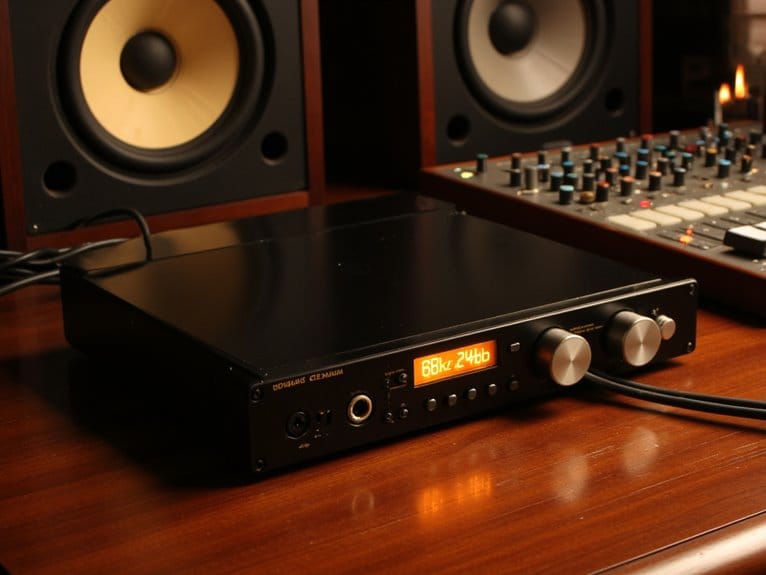
Once you’ve got your hardware sorted, the real magic happens when you configure your sample rate and bit depth settings correctly, and I’ll be honest—this is where I’ve seen countless producers either nail their workflow or create unnecessary headaches for themselves.
Your studio environment dictates much of this decision-making process, particularly when considering project goals and the recording techniques you’ll employ. For most music production, I recommend starting with 48 kHz at 24 bits, which provides excellent quality while maintaining reasonable file sizes and compatibility across different interface selection options. While many affordable options deliver studio-quality results under $200, investing in quality mic preamps can significantly impact your overall recording performance.
Genre considerations matter too—sound design projects often benefit from higher sample rates, while artist collaboration requires balancing quality with practical file sharing. Always consider your final playback devices when making these essential decisions.
Many budget-friendly interfaces now offer 24-bit recording capabilities that deliver professional results without breaking the bank.
File Size and Storage Considerations
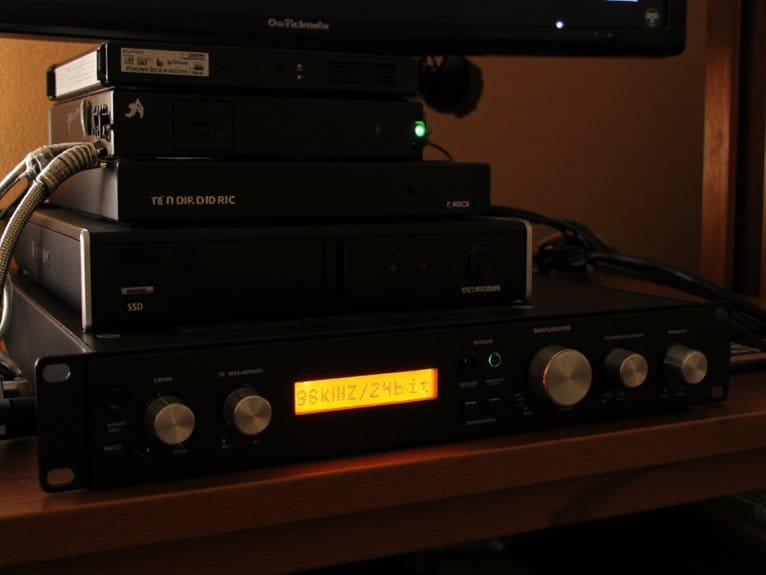
When dealing with digital audio files, I’ve learned that storage requirements can catch even experienced producers off guard, particularly because file sizes scale dramatically with higher bit depths and sample rates.
Your 45-minute album at 16-bit/44.1kHz consumes roughly 10MB, but that same project at 24-bit/192kHz balloons to 66MB—a sixfold increase that’ll strain your drives faster than you’d expect.
Storage needs multiply fast—your modest 10MB album becomes a 66MB storage hog when you upgrade those audio specs.
Essential file management strategies I’ve discovered include:
- Planning storage capacity based on your highest expected settings and track counts
- Understanding FAT32’s 4GB file limit affects continuous recording duration
- Calculating multitrack sessions consume space exponentially, not linearly
- Formatting drives properly before recording guarantees peak performance
Effective storage optimization techniques involve balancing quality needs against practical constraints, because running out of space mid-session teaches expensive lessons about preparation.
Professional streaming setups require 24-bit/192kHz resolution for optimal audio capture, which significantly impacts storage planning when managing multiple input channels and extended recording sessions. When using professional interfaces with 120dB dynamic range, the superior audio fidelity comes at the cost of larger file sizes that demand careful storage allocation.
Balancing Quality and Workflow Efficiency
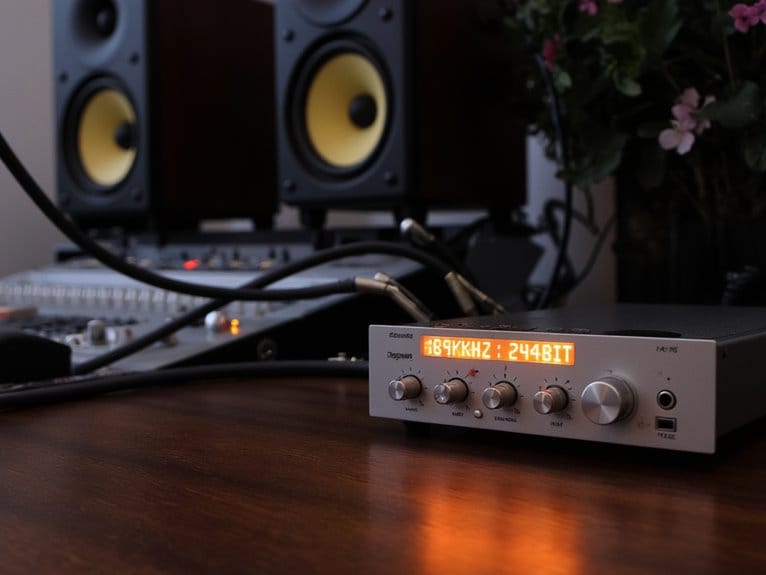
Because every producer faces the perpetual tension between capturing pristine audio and maintaining a responsive workflow, I’ve discovered that finding your ideal sample rate and bit depth sweet spot requires honest assessment of your system’s capabilities, project requirements, and listening environment.
| Configuration | CPU Load | Quality Benefits |
|---|---|---|
| 44.1kHz/16-bit | Low | Basic streaming |
| 48kHz/24-bit | Moderate | Professional standard |
| 96kHz/24-bit | High | Minimal improvement |
Through extensive sample rate optimization testing, I’ve found that 48kHz paired with 24-bit depth strikes the perfect balance for most workflows. While bit depth comparison reveals significant improvements from 16 to 24-bit due to increased dynamic range and lower noise floors, jumping beyond 48kHz often creates processing bottlenecks without delivering proportionate quality gains that justify the computational overhead.
Many professional mixers like the Mackie ProFX16v3 support 192kHz USB recording capabilities, though such extreme sample rates typically exceed the practical needs of most audio production scenarios. Premium interfaces with ultralow-noise preamps maintain signal integrity regardless of your chosen sample rate, making preamp quality equally crucial to your recording chain.
Frequently Asked Questions
Can I Change Sample Rate and Bit Depth Settings During Recording?
You generally can’t change sample rate and bit depth settings during active recording sessions, as most audio interfaces and DAWs require these parameters to be configured beforehand.
This limitation affects your recording flexibility since mid-session changes typically cause glitches, dropouts, or force session restarts.
I’ve learned that establishing your audio workflow with proper settings before hitting record prevents technical issues and maintains consistent file quality throughout your entire recording process.
What Happens When Converting Between Different Sample Rates and Bit Depths?
When you’re converting between different sample rates and bit depths, you’ll encounter conversion artifacts that can degrade your audio quality through interpolation errors, while sample rate mismatches create aliasing issues that muddy your sound.
I’ve found that each conversion introduces cumulative degradation, particularly noticeable in quiet passages where quantization errors become apparent. Though quality algorithms and proper dithering can minimize these effects.
Do Expensive Audio Interfaces Always Deliver Better Sound Quality Than Budget Ones?
Not necessarily—price perception often creates quality misconceptions when you’re evaluating audio interfaces.
While expensive models typically feature superior preamps, converters, and build quality, I’ve found that audible differences can be surprisingly subtle under typical recording conditions.
You’ll definitely notice improvements in stability, features, and workflow, but don’t assume that spending more automatically guarantees dramatically better sound quality for your specific needs.
How Do Sample Rate and Bit Depth Affect Real-Time Monitoring Latency?
Sample rate dramatically impacts your real-time monitoring delay since higher rates like 96 kHz cut latency roughly in half compared to 44.1 kHz, though I’ve found the CPU workload increases considerably.
Bit depth doesn’t directly affect these critical latency factors, focusing instead on audio quality and dynamic range.
Your monitoring techniques should prioritize optimizing sample rates and buffer sizes rather than chasing higher bit depths for latency reduction.
Are There Audible Differences Between 24-Bit and 32-Bit Recordings?
You’ll rarely hear direct differences between 24-bit and 32-bit recordings during playback, since both exceed human hearing capabilities.
However, I’ve noticed that 32-bit nuances become apparent during post-production, where the expanded headroom prevents clipping and preserves signal integrity.
While 24-bit advantages include smaller file sizes and universal compatibility, you’re more likely to perceive quality differences from your interface and processing chain than the bit depth itself.
On a final note
You’ve got the knowledge now to make informed decisions about your audio interface settings, whether you’re tracking vocals at 24-bit/48kHz or mixing at higher resolutions. I’ve found that starting with industry standards, then adjusting based on your specific workflow needs, saves both time and storage space. Remember, you can always record at higher quality and convert down later, but you can’t add resolution that wasn’t captured initially.

